2006 01 22
By Neil Freer | ufo.whipnet.org
Received from Light Eye
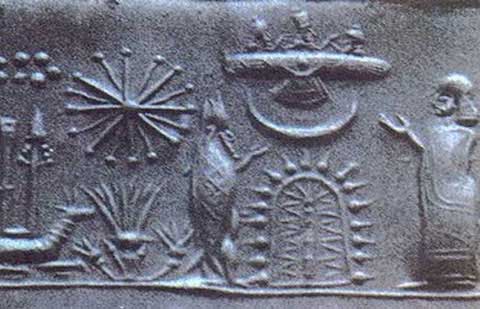
Sumerian Culture and the Annunaki
Working from the same archaeological discoveries, artifacts, and recovered records as archaeologists and linguists have for two hundred years, Sitchin propounds – proves, in the opinion of this author -- that the Anunnaki (Sumerian: “those who came down from the heavens”; Old testament Hebrew, Anakeim, Nefilim, Elohim; Egyptian: Neter), an advanced civilization from the tenth planet in our solar system, splashed down in the Persian gulf area around 432,000 years ago, colonized the planet, with the purpose of obtaining large quantities of gold. Some 250,000 years ago, the recovered documents tell us, their lower echelon miners rebelled against the conditions in the mines and the Anunnaki directorate decided to create a creature to take their place. Enki, their chief scientist and Ninhursag their chief medical officer, after getting no satisfactory results splicing animal and Homo Erectus genes, merged their Anunnaki genes with that of Homo Erectus and produced us, Homo Sapiens, a genetically bicameral species, for their purposes as slaves. Because we were a hybrid, we could not procreate. The demand for us as workers became greater and we were genetically manipulated to reproduce.
Eventually, we became so numerous that some of us were expelled from the Anunnaki city centers, gradually spreading over the planet. Having become a stable genetic stock and developing more precociously than, perhaps, the Anunnaki had anticipated, the Anunnaki began to be attracted to humans as sexual partners and children were born of these unions. This was unacceptable to the majority of the Anunnaki high council and it was decided to wipe out the human population through a flood that was predictable when Nibiru, the tenth in our solar system and the Anunnaki home planet, came through the inner solar system again (around 12,500 years ago) on one of its periodic 3600 year returns. Some humans were saved by the action of the Anunnaki official, Enki, who was sympathetic to the humans he had originally genetically created. For thousands of years, we were their slaves, their workers, their servants, and their soldiers in their political battles among themselves. The Anunnaki used us in the construction of their palaces (we retroproject the religious notion of temple on these now), their cities, their mining and refining complexes and their astronomical installations on all the continents. They expanded from Mesopotamia to Egypt to India to South and Central America and the stamp of their presence can be found in the farthest reaches of the planet.
Around 6000 years ago, they, probably realizing that they were going to phase off the planet, began, gradually, to bring humans to independence. Sumer, a human civilization, amazing in its “sudden”, mature, and highly advanced character was set up under their tutelage in Mesopotamia. Human kings were inaugurated as go-betweens, foremen of the human populations answering to the Anunnaki. A strain of humans, genetically enhanced with more Anunnaki genes, a bloodline of rulers in a tradition of “servants of the people” was initiated (Gardner). These designated humans were taught technology, mathematics, astronomy, advanced crafts and the ways of advanced civilized society (in schools, called now “mystery schools” but there was no mystery about them). Gardner has brought to light the fact that there exists a robust, highly documented, genealogical, genetic history carrying all the way back to the Anunnaki, possessed by the heterodox tradition of Christianity, which is only now coming forward, no longer gun-shy of the Inquisition. This tradition, preserving the bloodline, is the one branded “heretical” and murderously persecuted by the Roman Church. There were no Dark Ages for this tradition, only for those whom the Church wanted to keep in the dark about the real nature of human history and destroy the bloodline, a direct threat to the power of the Bishops.
What evidence supports the Sitchin thesis?
The Astronomical Evidence
“...no concrete problem is going to be solved as long as the experts of astronomy are too supercilious to touch "mythical" ideas -- which are firmly believed to be plain nonsense, of course -- as long as historians of religion swear to it that stars and planets were smuggled into originally "healthy" fertility cults and naive fairy tales only "very late" -- whence these unhealthy subjects should be neglected by principle -- and as long as the philologists imagine that familiarity with grammar replaces that scientific knowledge which they lack, and dislike.” - Giorgio de Santillana, Ph.D.& Hertha von Dechend, Ph.D., "Hamlet's Mill"
A key underpinning of the Sitchin paradigm is the existence, now or in the past, of the tenth planet in our solar system, the home planet of the Anunnaki with the size, orbit, and characteristics described, as Sitchin has demonstrated, in the Enuma Elish and corroborated by Harrington, former chief of the U.S. Naval Observatory, now deceased.
Tombaugh discovered Pluto in 1930. Christie, of the U.S. Naval Observatory, discovered Charon, Pluto’s moon, in 1978. The characteristics of Pluto derivable from the nature of Charon demonstrated that there must still be a large planet undiscovered because Pluto could not be the cause of the residuals, the “wobbles” in the orbital paths of Uranus and Neptune clearly identifiable. The IRAS (Infrared Astronomical Satellite), during ’83 -’84, produced observations of a tenth planet so robust that one of the astronomers on the project said that “all that remains is to name it” -- from which point the information has become curiously guarded. In 1992 Harrington and Van Flandern of the Naval Observatory, working with all the information they had at hand, published their findings and opinion that there is, indeed, a tenth planet, even calling it an “intruder” planet. The search was narrowed to the southern skies, below the ecliptic. Harrington invited Sitchin, having read his book and translations of the Enuma Elish, to a meeting at his office and they correlated the current findings with the ancient records.
The recovered Enuma Elish document, a history of the formation of our solar system and more, says that, at the time when Mercury, Venus, Mars, Jupiter, Uranus and Saturn were in place, there was a Uranus sized planet, called Tiamat, in orbit between Mars and Jupiter. Earth was not in place yet. A large wandering planet, called Nibiru, was captured into the system gravitationally. As it passed by the outer planets it caused the anomalies of their moons, the tilting of Uranus on its side, the dislodging of Pluto from its being a moon of Saturn to its own planetary orbit. Its path bent by the gravitational pull of the large planets, first its satellites collided with the large planet Tiamat and, on a second orbit through, Nibiru collided with Tiamat, driving the larger part of it into what is now Earth’s orbit to recongeal as Earth, dragging its moon with it to become our Moon with all its anomalies. The shattered debris of Tiamat’s smaller part became the asteroid belt, comets, and meteorites. The gouge of our Pacific basin is awesome testimony to the collisional event. Nibiru settled into a 3600 year elliptical retrograde (opposite direction to all the other planets) orbit around our sun, coming in through the asteroid belt region between Mars and Jupiter at perigee and swinging far out past Pluto at apogee. Harrington acknowledged that his information agreed with all these details and the maps they each had drawn of the orbits were almost indistinguishable. The current probable location of Nibiru (Planet X, our tenth) estimated by both was the same.
It is the opinion of this author and others that, in light of the evidence already obtained through the use of the Pioneer 10 and 11 and two Voyager space craft, the Infrared Imaging Satellite (IRAS, ‘83-84) and the clear and unequivocal statements of Harrington when consulting with Sitchin, that the search has already been accomplished, in fact that the planet has already been found.
We need to force the issue of the tenth planet being in our solar system, not just to demonstrate the validity of the new paradigm but for a very practical reason. The ancient records are very clear. The passage of the tenth planet, Nibiru, once every 3600 years, through the inner solar system effects the Earth, sometimes in catastrophic ways. It is very probably the cause of pole shifts, pole reversals, changes in the precessional movement, perhaps even catastrophic bombardment by asteroid size space debris that it may drag along with it. Since it passes through the asteroid belt area between Mars and Jupiter and its orbital path may vary depending on the position of the other planets when it comes though, it may have been responsible for the devastation of Mars. A rigorous, detailed computer modeling of the solar system, including the tenth planet needs to be done urgently for our own planetary safety. Remember that the Vatican maintains an astronomical observatory and Msgr. Balducci may have access to information that prompts him to make the amazing statements he has ---- no doubt as voice of the Vatican.
The Technological Evidence
Ooparts is the term used to describe the purportedly out of place in time artifacts, toys, tools, technical devices, depictions and documents which have come to light through archaeological excavation or discovery. Almost everyone is familiar, through published works or documentaries, with the clay pot batteries still containing the electrodes from the Iraqi desert dated at 2500 B.C., the flyable model airplane from a pyramid tomb, the sophisticated machining of stone requiring the most advanced techniques we know today, the 1000 ton precision cut blocks of stone in a temple foundation that we could not even handle, an ancient relief frieze from an Abydos temple depicting rockets, airplanes and even a helicopter, etc. The most recent and quite amazing oopart is the rediscovery of monoatomic gold by David Hudson (Monoatomics are superconductors at room temperature, have anti-gravitic properties and are only now being investigated by the advanced physics community) Hudson’s discovery, correlated with the bringing to light, by Gardner, of the suppressed discovery of the Anunnaki gold processing plant on Mt. Horeb by Sir Flinders Petrie in 1889 demonstrates that the monoatomics were already known at least 3000 years ago. These ooparts coupled with evidence from many disciplines and the historical records indicate that an advanced civilization existed in those times possessing a high technology and that that civilization was indeed the Anunnaki.
The Documentary Evidence
The recorded historical documentation for the existence and deeds of the Anunnaki has become gradually available to us only since the early 1800’s. The excavation of the ancient sites of Mesopotamia brought to light the amazingly advanced civilization of Sumer and, with it, thousands of clay tablets containing not only mundane records of commerce, marriages, military actions and advanced astronomical calculation systems but of the history of the Anunnaki themselves. It is clear from those records that the Sumerians knew these aliens to be real flesh and blood. The library of the ruler, Ashurbanipal, at Nineveh was discovered to have burnt down and the clay tablets held there were fired, preserving them for our reading. One of the most impressive finds, in very recent time, has been a sealed, nine foot by six foot room in Sippar holding, neatly arranged on shelves, a set of some 400 elaborate clay tablets containing an unbroken record of the history of those ancient times, a sort of time capsule. The evidence is so overwhelming and robust that, if it weren’t for those with power enough to suppress, it would have been accepted and our world view changed a century ago or, perhaps, sooner.
The Genetic Evidence
The recovered records place the location of the Anunnaki laboratory where the first humans were literally produced in east central Africa just above their gold mines. This falls precisely on the map where the mitochondrial DNA “search for Eve” places the first woman Homo Sapiens and in the same period. (The gold mining engineers of Africa have found 100,000-year-old gold mines in that area.) The evidence for, and description of advanced genetic engineering is all there in the ancient documents. Our rapid progress from inception to going to Mars soon, after only 250,000 years, does not correspond to the million year periodicities of slow evolutionary development of other species such as Homo Erectus before us. As so many thinkers have pointed out, we are radically and anomalously different, as discussed in part three.
Scientific Objections to the Thesis
How could the Anunnaki, clearly described as comfortable in earth gravity and atmosphere, very similar to current humans in all ways, have evolved on a planet within our solar system whose orbital apogee takes it into the deep cold of space for much of its orbit?
The ancient records repeatedly describe Nibiru as a “radiant” planet. This may be understood as having a high core temperature. Although controversial, there is also astrophysical opinion that a large body in elongated orbit is constantly tending toward circular orbit and this causes stresses in the body that could generate a good deal of heat. That their planet is gradually cooling, may be indicated by Sitchin’s interpretation of their colonizing Earth (contains most of the gold identifiable in the solar system) for the purpose of obtaining large quantities of gold for molecular seeding of their atmosphere with a reflective gold shielding. Pertinent here is Harrington’s confident statement to Sitchin that it is “a nice, good planet, could be surrounded by gases, probably has an atmosphere and could support life like ours”. The sunlight level there might be quite different than on earth. The Anunnaki were often depicted or sculpted with what seem to be obviously sunglasses.
If, however, the Anunnaki evolved on a radically different planet from earth under quite different conditions to which to adapt, why should they have turned out to be so identical to human species? Sitchin’s answer is based on the collisional event between the intruder planet, Nibiru, and the planet Tiamat, the residual part of which recongealed into the Earth after being driven into current Earth orbit. That the two, or at least one, of the colliding planets was sufficiently developed to have evolved basic organic compounds, perhaps even simple life, the cross-seeding of everything from amino acids to more complicated organic compounds or even primitive organisms, could account for the evolutionary similarity. Although this author finds it a reasonable hypothesis, even trivial, that advanced civilizations would be capable of crossing extremely different genomes, perhaps with even radically different bases, the cross-seeding theory can account for the apparent relative ease with which the Anunnaki impinged their genes on the genes of Homo Erectus. The Anunnaki skill level, 200,000 years ago, is indicated well by the recorded fact that, in early trials, they succeeded in crossing animal genes with Homo Erectus genes, obtained living hybrids but never a satisfactory product which led them to modify Homo Erectus genes with their advanced genes.
If our genome is estimated as 98% to 99% similar to the chimpanzee, how could there be a melding of the Homo Erectus and Anunnaki genomes, or impingement of the advanced code on the lesser advanced one detectable? The author suggests that this is a major question probably answerable only by the geneticists open-minded enough to attack it. The resolution of that question should provide rich additional clues in itself.
Article from: http://ufo.whipnet.org/creation/annunaki.sumerian/index.html
Related:
Zecharia Sitchin
Genesis Revisted
The Myth of a 12th Planet
A Brief Analysis of Cylinder Seal VA 243
By Michael S. Heiser Ph.D. | sitchiniswrong.com
Michael S. Heiser Ph.D. candidate, is a scholar of the Hebrew Bible and Ancient Semitic Languages at the University of Wisconsin-Madison
The Following are excerpts from Micheal S. Heisers pdf file: The Myth of a 12th Planet: A Brief Analysis of Cylinder Seal VA 243
Please visit: sitchiniswrong.com for more articles and information.
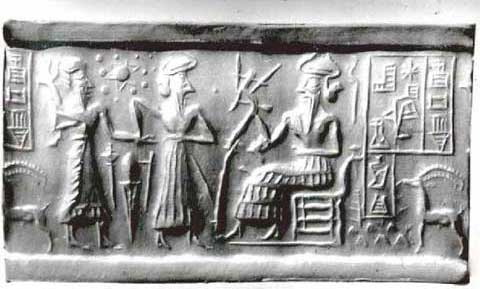
Introduction
Readers of Zecharia Sitchin’s books, particularly The 12th Planet, will recognize the above seal, VA 243 (so named because it is number 243 in the collection of the Vorderasiatische Museum in Berlin). This seal is the centerpiece of Sitchin’s theory that the Sumerians had advanced astronomical knowledge of the planetary bodies in our solar system. This knowledge was allegedly given to the Sumerians by extraterrestrials, whom Sitchin identifies as the Anunnaki gods of Sumero-Mesopotamian mythology. In the upper left-hand corner of the seal, Sitchin argues, one sees the sun surrounded by eleven globes. Since ancient peoples (including the Sumerians according to Sitchin) held the sun and moon to be “planets,” these eleven globes plus the sun add up to twelve planets. Of course, since we now know of nine planets plus our sun and moon, part of Sitchin’s argument is that the Sumerians knew of an extra planet beyond Pluto. This extra planet is considered by Sitchin to be Nibiru, an astronomical body mentioned in Mesopotamian texts. Sitchin’s works detail his contention that Nibiru passes through our solar system every 3600 years, and so some believers in Sitchin’s theory contend that Nibiru will return soon. Some followers of Sitchin’s ideas also refer to Nibiru as “Planet X”.
Is Sitchin correct – in whole or in part? Is Nibiru a 12th planet that will soon return? Does VA243 prove his thesis? Unfortunately for Sitchin and his followers, the answer to each of these questions is no. This paper will focus on the heart of his theory, VA243. Nibiru is the subject of another paper on my website.
Method and Approach
The study of cylinder seals is actually a very specialized sub-discipline within Sumerology and Assyriology.a It is possible to determine, through the efforts of cylinder seal specialists of the recent past and current experts, to decisively say that Sitchin’s interpretation of this seal is deeply flawed and lacks scholarly merit. In short, his theory is false and is unsupported by the seal itself.
In the discussion that follows, I will demonstrate that VA243 in no way supports Sitchin’s ideas. My reasons / lines of argument for this are:
1) The inscription on the seal (left hand and right hand sides – which are not discussed by Sitchin) says nothing about planets or any element of astronomy. Rather than offering an independent translation, I will defer to authorities on Sumerian seal inscriptions in this regard to avoid any charge of bias.
2) The alleged “sun” symbol on the seal is not the sun. We know this because it does not conform to the consistent depiction of the sun in hundreds of other cylinder seals and examples of Sumero-Mesopotamian artwork. I will describe the typical depiction (determined with certainty because it appears with texts about the sun god [Shamash Akkadian, known as Utu in Sumerian]) and provide image examples. Sources are provided for readers to check for themselves. The “sun” symbol is actually a star (which in Mesopotamian art could have six or, more commonly, eight points). Lest the modern reader retort that “well, the sun is a star,” I offer several images where the star symbol and the sun symbol (which again, is not that in VA243) are side-by-side and distinct from one another. The Sumerians and Mesopotamians distinguished the sun from stars by using different symbols – and associating each symbol with the sun god and other gods, respectively. There is simply no ancient Sumero-Akkadian evidence to support Sitchin’s identification.
3) If the “sun” is not the sun, then what are the dots? The dots are also stars, as is best illustrated by the Sumerian-Mesopotamian depiction of the Pleaides (seven dots together with reasonable astronomical accuracy since they are visible to the naked eye).b The Pleaides are actually one of the most frequently depicted astronomical features in Sumero-Mesopotamian art. As Sitchin points out (and this is corroborated by actual scholars in the field - it’s common knowledge), stars were associated with or considered to be heavenly beings – gods. In Sumero-Mesopotamian artwork, a star represents either a god or an astronomical body. The same can be said of the sun – it can either reference the literal sun or the sun god. There are three possibilities as to what VA243 is depicting:
(A) It is singling out a deity or special star and associating it with other stars in some sort of zodiacal representation. I don’t consider this likely because there are other far clearer representations of zodiacal constellations. Unless there are clear zodiacal connotations, a star was symbolic of a deity, which brings us to the second option.
(B) More probable is the idea that the central star stands for a deity that has some association with fertility (as in crops) since the inscription describes an offering made by a worshipper (who is named) to a seated god who is associated in the seal with fertile harvest. Since there are two other figures in the seal in addition to the seated god, and one is the offerer, the remaining figure is likely a deity also associated with the offering. In favor of this possibility are the “implements” shown on the seal with respect to these two figures facing the seated god and the figure’s headdress. Also in its favor is the fact that there are literally hundreds of such “offering seals,” and many have a star in upper proximity to the figures’ heads, signifying the figure is a deity (see the example).
(C) Since the star is surrounded by eleven other stars (dots), the artistic depiction could stand for the lead god of the Mesopotamian divine council and its other eleven (upper tier) members. Recall that (as Sitchin again points out) the Mesopotamian council had 12 members. I have noted before that the 12 member council isn’t always consistent in Mesopotamian religion (at times eight gods are considered the council), but 12 is the more prevalent number. This thesis is attractive, but I can’t say there is much to commend it over option B. The reader might be thinking at this point, “Well, isn’t the sun god the leader of the pantheon – so if this symbology points to the divine council the center symbol could still be the sun?” This would be an erroneous line of thought since in Sumero-Mesopotamian religion the sun god is NOT the high god; the high god is Anu (later, Marduk), not Shamash.
These options are admittedly subjective, but one thing is certain – the “sun” symbol does not conform to the abundantly frequent symbol for the sun in Sumero-Mesopotamian art. We are not dealing with a depiction of the solar system. Astronomer Tom van Flandern pointed this out years ago anyway, since the sizes of the “planets” around the alleged sun do not conform to the correct sizes of the planets and there distances from the pseudo-sun are not depicted in such a way as to depict elliptical (or at least varying) orbits. The link to van Flandern’s critique is on my website.
4) There is not a single text in the entire corpus of Sumerian or Mesopotamian tablets in the world that tells us the Sumerians (or later inhabitants of Mesopotamia) knew there were more than five planets. This is quite a claim, but is demonstrable through the work of scholars who specialize in cuneiform astronomy. Below I list all the major works on cuneiform astronomy (catalogues of texts, dissertations / books) and invite readers to check them out of a library and look for themselves. Literally every cuneiform text that has any astronomical comment (even with respect to astrology and omens) has been translated, catalogued, indexed, and discussed in the available academic literature. The tablets are often quite detailed, even discussing mathematical calculations of the appearance of planetary bodies in the sky, on the horizon, and in relation to other stars. The field is by no means new, and is considerably developed.
All of the above facets of the discussion are now offered in more detail with bibliography.
I. The Inscriptions on VA 243
VA243 has three lines of text (“line 1” is actually repeated on both sides of the seal):
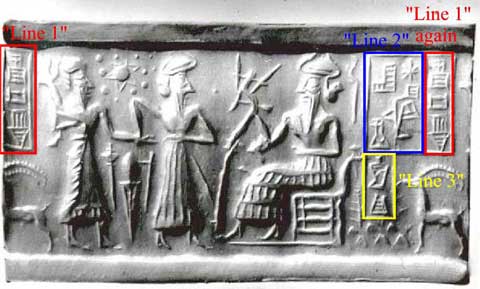
The seal is transliterated (the Sumero-Akkadian signs in English letters) and translated in the principal publication of the Berlin Vorderasiatische Museum’s publication of its seal collection, Vorderasiatische Rollsiegel (“West Asian Cylinder Seals”; 1940) by Mesopotamian scholar Anton Moortgat on page 101. This book is in German, so I offer the German and an English translation:
Line 1 = dub-si-ga “Dubsiga” [a personal name of an apparently powerful personc]
Line 2 = ili-il-la-at “Ili-illat” [another personal name, this time of the seal’s owner]
Line 3 = ir3-su “dein Knecht” [German for “your servant”d]
So the full (rather boring) inscription of VA243 reads: “Dubsiga, Ili-illat, your/his servant.” Nothing in the inscription suggests anything remotely to do with astronomy or planets.
In an email correspondence with Dr. Rudi Mayr, whose dissertation was on cylinder seals, Dr. Mayr commented on the inscriptions and the seal [and I interject a few comments in brackets]:
“The seated figure is a god; the ‘flounced’ garment is normal for deities (though kings start wearing them a little later); deities also have the distinctive headdress. Most scholars call it a ‘horned’ headdress, but I’ve always thought it looked more like flames than horns. Ancient texts often refer to deities having a bright, shining, brilliant aspect [this is true across the ancient near east – witness the “shining one” terminology I discuss in The Façade and in several papers on my website]; they don’t mention horns . . . The introducing figure also has the ‘horns’ of divinity” [this is a strong contextual argument that the symbol – again, it’s not the “sun” – to the upper left of the introducing figure is a star. Precisely because they SHINE, stars were associated with deities. Shamash, the sun god, had his own symbol of the sun. See below for what it looked like].
II. The “Sun” Symbol
This is perhaps the biggest problem with Sitchin’s interpretation of VA243 signifying the solar system. Simply put, if the central symbol in his solar system isn’t the sun, the interpretation collapses completely. There’s actually a good deal of evidence to demonstrate decisively that Sitchin is wrong here. Toward offering that evidence, we’ll first introduce a few general comments on Sumero-Akkadian symbols and move to the specifics.
A. General Comments
Like all ancient religions, Sumero-Mesopotamian religion had a great concern with heavenly bodies that could be observed with the naked eye. In particular, the sun, moon, and Venus were important focus points because of their ease of visibility, and each was artistically symbolized and stood for a deity.
In Sumer-Mesopotamian religion, the sun god symbology was very clear:
Sun god = Shamash (Utu in the Sumerian languagee)
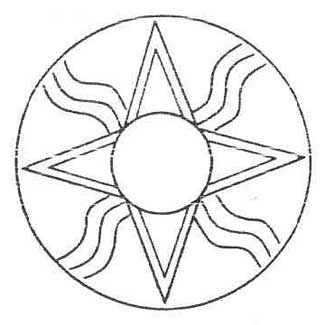 The symbol of the sun god in Sumero-Mesopotamian religion was a central circle with four extended “arms” with wavy lines in between each “arm” (most common), or a circle with only wavy lines. The entire symbol was itself nearly always [I don’t know any exceptions, but there may be one – just being cautious here] inside a circle, as right:f
The symbol of the sun god in Sumero-Mesopotamian religion was a central circle with four extended “arms” with wavy lines in between each “arm” (most common), or a circle with only wavy lines. The entire symbol was itself nearly always [I don’t know any exceptions, but there may be one – just being cautious here] inside a circle, as right:f
The reader should note immediately that this is NOT the symbol on VA243. VA 243’s “pseudo-sun” lacks the wavy lines and is not set inside a circle.
This sun symbol is ubiquitous in Sumero-Mesopotamian religious artwork. The other common symbol for the sun god was the god in flight upon a set of wings (a depiction akin to the winged disc in Egyptian religion).
The above classic solar disk iconography in Sumero-Mesopotamian religion is contrasted with the star symbol, used to symbolize either stars in constellations, any deity (the star is either over the deity’s head or above it to the left of right), or Ishtar (Sumerian Inana), who stood for Venus, the most visible object in the sky aside from the sun and moon:g
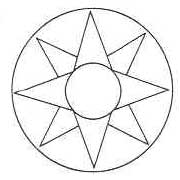 Note that this example has eight points. This is the most frequently attested style in Sumero-Mesopotamian religious art. The star also is found with six (like VA 243) or seven points, and the points even vary within the same seal or stela carving. It wasn’t consistent in points, but what the symbol stood for was consistent – either a star, planet, or deity – but NOT the sun. The star symbol is either set within a circle or, far more often, not within a circle. It is clearly distinct from the sun symbol.
Note that this example has eight points. This is the most frequently attested style in Sumero-Mesopotamian religious art. The star also is found with six (like VA 243) or seven points, and the points even vary within the same seal or stela carving. It wasn’t consistent in points, but what the symbol stood for was consistent – either a star, planet, or deity – but NOT the sun. The star symbol is either set within a circle or, far more often, not within a circle. It is clearly distinct from the sun symbol.
How do I know that the symbol of VA 243 is a star and not the sun disk? Other than the obvious noted above – that VA 243 does not have the wavy lines between the “arms” of the symbol and is not set within a circle - Sumero-Mesopotamian religion often grouped the symbols for the sun god with that of the moon god (Akkadian = Sin; Sumerian = Nanna) and Ishtar (Sumerian = Inana). This isn’t surprising since they were so readily viewed. In short, they didn’t confuse the symbols and neither should we.
This grouped threesome is very prevalent in Sumero-Mesopotamian art, and compels the observation that the sun symbol and star symbol were distinguished from each other:
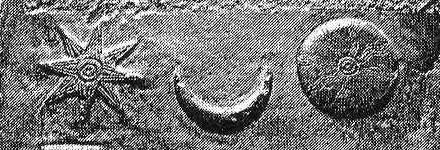
Source: Ursula Seidl, Die Babylonischen Kudurru Reliefs, Tafel 11, Zweite Gruppe, stela “a” = The Babylonian Kudurru Reliefs, Plate 11, 2nd Group, stela “a”. Note the wavy lines and encircled sun symbol on the right.
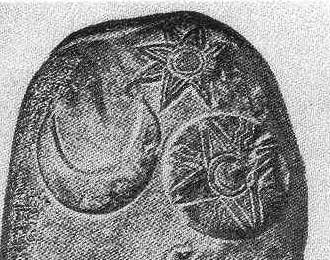
Ursula Seidl, Die Babylonischen Kudurru Reliefs, Tafel 19, Vierte Gruppe, stela “b” = The Babylonian Kudurru Reliefs, Plate 19, 4th Group, relief “b”. Note the wavy lines and encircled sun symbol on the lower right.
The symbols for sun and star/planet are also distinguished clearly in zodiacal artwork from Mesopotamia:
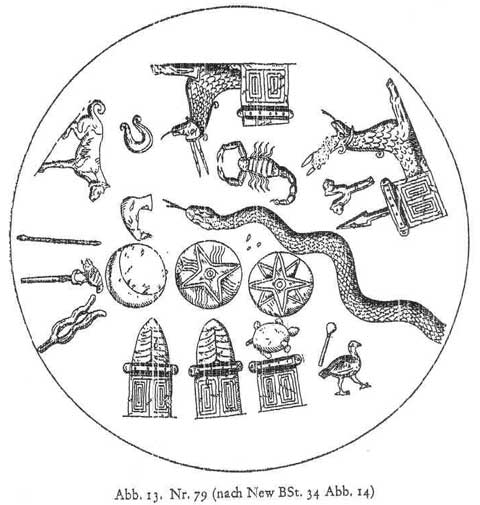
Source: Ursula Seidl, Die Babylonischen Kudurru Reliefs, p. 47 = The Babylonian Kudurru Reliefs, p. 47
The sun symbol (Left) and star symbol (Right) are next to each other under the snake (Draco). Note the wavy lines of the sun symbol
Here is a close-up of the sun (L) and star (R) symbol above. Note that the star in this case has eight points:
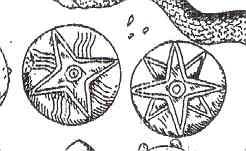
A second zodiac example:
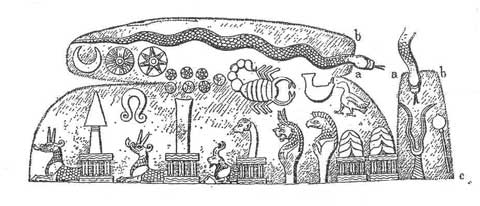
Source: Ursula Seidl, Die Babylonischen Kudurru Reliefs, p. 60 = The Babylonian Kudurru Reliefs, p. 60
The sun symbol (center) and star symbol (R of center) are next to each other under the snake’s tail. Note the wavy lines of the sun symbol
In the above example, note that: (1) the star has seven points, and (b) the stars below it have six points. Note also that these smaller stars also LACK points – they are just dots. This seven dot/circle arrangement is one of the most common motifs in Mesopotamian art, and denote the Pleiades.
The point here is that dots = stars in Mesopotamian art when in an astronomical context (or a context where a deity is identified with a star). This is important for our consideration of VA 243.
Again, here is a close-up:

A third zodiac example:
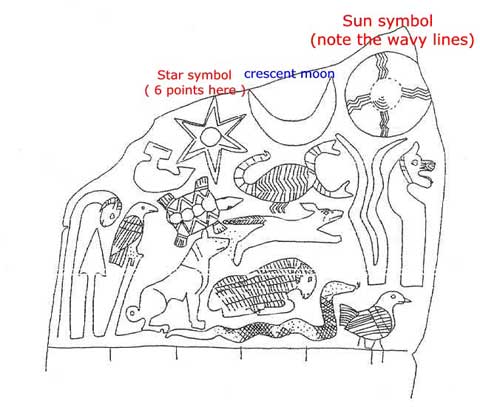
Source: Ursula Seidl, Die Babylonischen Kudurru Reliefs, p. 23 = The Babylonian Kudurru Reliefs, p. 23
Note that the star symbol here has six points as does the VA 243 star.
Some commentary on this last example is in order. The previous two examples clearly are in zodiac context, as is this one. Those previous two examples clearly have the sun symbol drawn in a manner consistent with expected Sumero-Mesopotamian features (wavy lines, encircled) that unmistakably distinguishes the sun from the star symbol. The star symbol signifies the same astronomical body in each case, yet the number of points varies. This means that the number of points is unimportant for identifying the star symbol as a STAR or planet, NOT the sun. Hence one cannot say, “well the star symbol usually has eight points, and the Sitchin seal has six, therefore it’s not a star but the sun.” This is erroneous because these examples demonstrate clearly that a star symbol can have 6, 7, or 8 pts., and LACKS wavy lines. The symbol on Sitchin’s VA 243 is NOT the sun. It is a star, and thus denotes a star, a god, or a single planet. This isn’t my opinion, it’s the Sumero-Mesopotamian art convention.
Please note that this article continues discussing cylinder seal examples of star symbols: http://www.sitchiniswrong.com/VA243seal.pdf
Related: sitchiniswrong.com
A Chronological Bible Timeline Part 1, 4000 BC - 2343 BC
Sons of God, Daughters of Men - Who are the Nephilim?
Kenneth Grant and the Merovingian Mythos
Secret Societies, Satanic Sects, The Prieure du Sion, The Knights Templars and Freemasons
Enochian Aliens?
